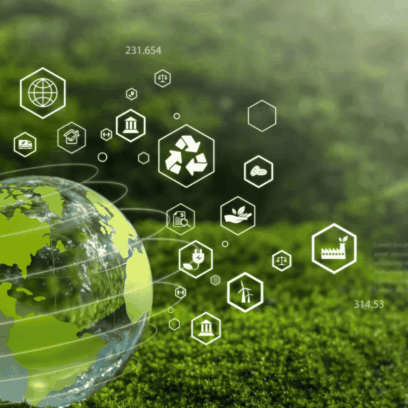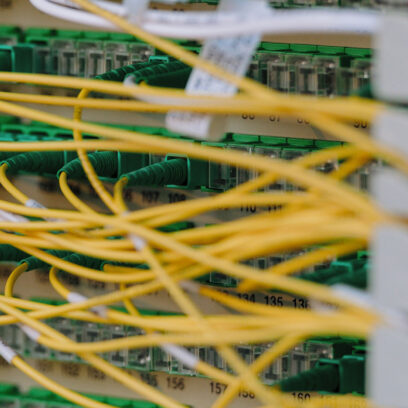Decarbonizing Ports & Maritime
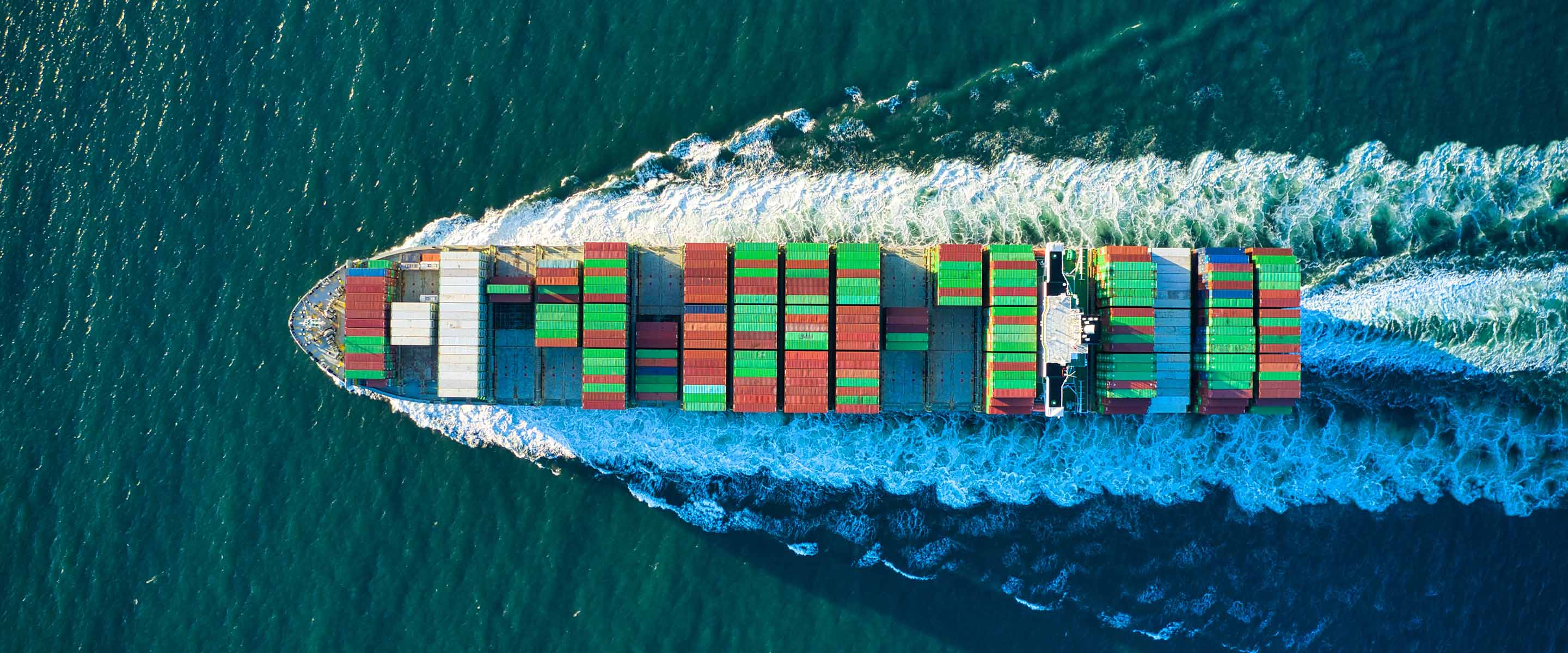

SUSTAINABILITY REPORTING OVERVIEW
Sustainability reporting serves as a valuable tool to achieve corporate commitments and better manage climate-related business risks. This white paper walks you through what’s typically included and what should be considered.

FW Sustainability Report
Learn more about how Fierce Whiskers has made sustainable choices every step of the way by downloading its full sustainability report.
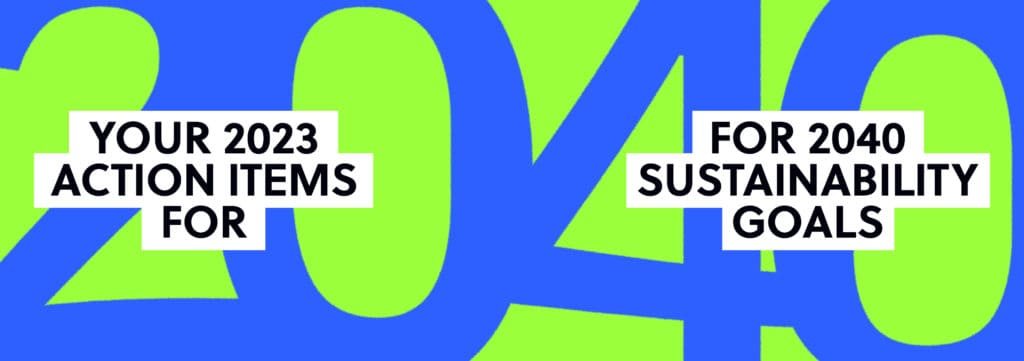
Your Action Items for 2040 Net-Zero
Over 702 companies on the Forbes 2000 have made net-zero pledges. Whether your organization has made a pledge or plans to make one soon, there’s a massive difference between pledging net-zero and achieving it. Do you have a clear roadmap for your sustainability journey? What are the right steps to consider to achieve 2040 net-zero carbon, water, and waste goals? It’s time to create a clear roadmap.
Insights into the ports & maritime industry’s GHG impact and actionable steps for decarbonization and climate risk reduction.
Although shipping is far less emissions intensive than other modes of freight transportation such as rail or truck, the sheer volume of maritime trade, which is over 10 billion tonnes of cargo every year, results in the ports and maritime sector accounting for around 3% of global greenhouse gas (GHG) emissions. Without sufficient timely action on emissions reduction, this figure could reach 17% by 2050. Earlier this year, the International Maritime Organization (IMO) revised and strengthened its GHG reduction targets to be compatible with the Paris Agreement’s aim to limit global warming to no more than 1.5°C above pre-industrial levels. In an effort to work towards these goals, several organizations and initiatives, such as the World Ports Sustainability Program (WPSP), have explored various operational, technology, and policy solutions to drive sustainability in the industry. All market participants should strive to have a strong understanding of the climate risks they face, their environmental footprints, and the strategies they can use to improve their relationship with the environment.
Climate Risk
While the ports, maritime, and shipping industry gives rise to climate change through its operations and activities, this same industry also simultaneously faces increased risks from the impacts of the climate crisis that it contributes to. These climate risks can be categorized into physical and transition risks.
Physical Risk
Due to the ports and maritime industry’s dependence on favorable weather and environmental conditions along with many of its operations being located in coastal areas, it is particularly susceptible to physical climate risks, which are defined as the risks arising from changes in climate patterns and extreme weather events. Around one-third of the world’s ports are located in a tropical band that is vulnerable to the most powerful effects of climate change. As GHG emissions increase, heat gets trapped in the atmosphere, leading to warmer water and air temperatures that the industry must account for in risk assessments and planning.
Storms and Flooding
Water has a very high heat capacity relative to air and helps absorb the increased heat in the atmosphere, with the ocean holding an estimated 91% of this excess heat energy. One significant impact arising from warmer air and ocean temperatures is an increased intensity of tropical storms. Warm water increases evaporation, and warm air can hold more water vapor. This relationship fuels tropical storms, which are enabled to pick up more water and push moist air upwards more quickly, resulting in more intense rainfall and wind speeds. At sea, these storms can cause harm to vessels, cargo, and crew, in addition to delays through rerouting. The storms that make landfall can significantly damage port infrastructure and delay operations, and these impacts are further intensified by sea level rise.
Sea level rise is primarily driven by the combination of melting glaciers and ice sheets with the thermal expansion of the ocean as it warms. Global sea levels are projected to rise between 0.28-1.01 meters by the end of the century. By 2050, damaging coastal flooding is expected to occur 10 times more frequently than it does today, due to increasing storm surge and tide heights. One study found that approximately $8.1 billion in damage from Hurricane Sandy can be attributed to climate change-related sea level rise. In addition to intensifying storm impacts, sea level rise may require adaptation measures for shoreline and flood protection.
Similar to tropical storms, inland rainfall is also intensified by evaporation and the increased water capacity of warm air, meaning that areas far from coasts can also expect more damaging flooding. The 2019 flooding of the Upper Mississippi River resulted in a closure of 38 consecutive days at the St. Louis Harbor, and approximately $1 billion worth of grain unshipped.
Droughts and Extreme Heat Events
Although tropical storms and sea level rise are considered to present a greater risk to the shipping industry, the effects of rising air temperatures, heatwaves, and droughts should not be disregarded. With there being a 98% likelihood that the next five-year period will be the warmest on record, it can be expected that the impacts of high temperatures and related events will continue to worsen. Warm air temperatures place stress on cooling systems and associated energy demands, in addition to degrading infrastructure made of materials whose integrity can be compromised due to heat, such as metal and pavement. Additionally, heatwaves can cause unsafe working conditions for employees, potentially resulting in operational delays.
High temperatures can also exacerbate droughts, which can in turn cause operational disruptions. One current example of drought hampering global maritime operations is at the Panama Canal. With the canal experiencing its worst drought in history, the lake that feeds it isn’t able to support normal throughput rates, and ships are facing six days of delays. Although countries in the Americas are most significantly affected by this, its effects are also reaching areas as far as Europe and Asia.
Figure 1. Impacts of drought in Panama on global trade flows
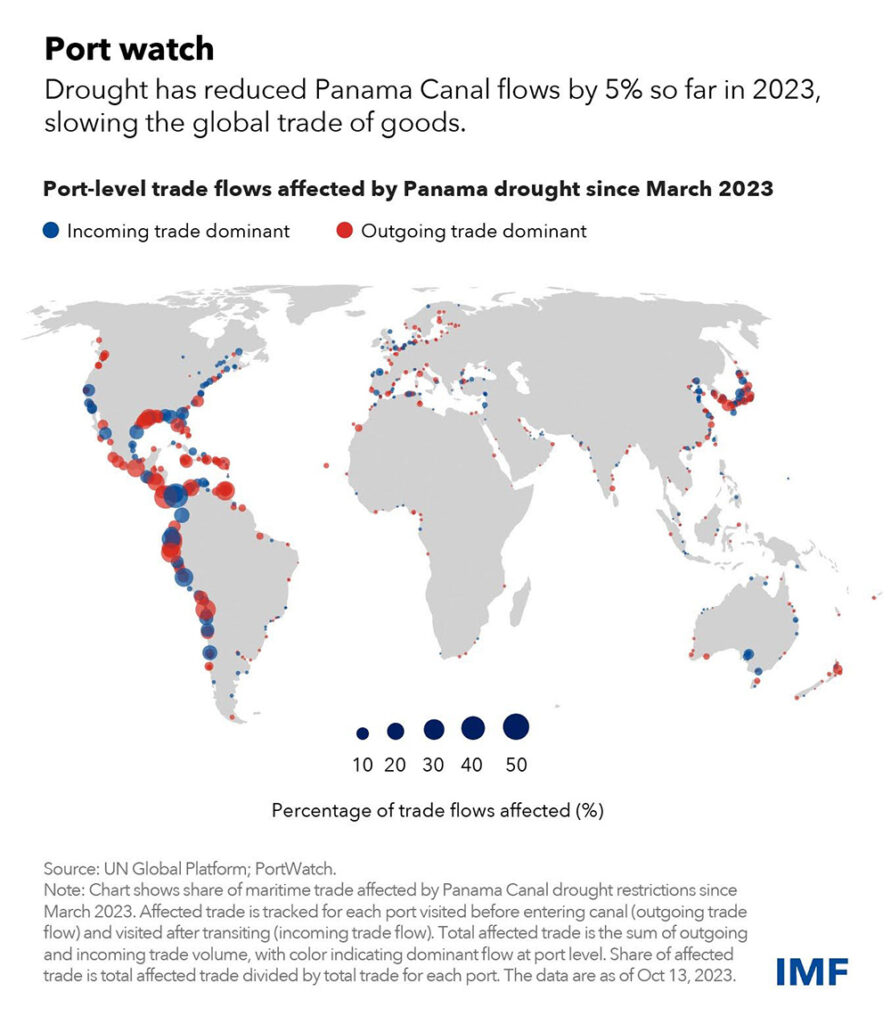
Source: IMF
Transition Risk
In addition to impacts from the physical effects of climate change, the ports and maritime industry is also exposed to transition risks. These come from the regulatory, market, reputation, and technology shifts which occur as part of the transition to a more climate-friendly world.
Regulatory Risk
The sustainability regulatory environment is rapidly expanding, and market participants need to ensure they are prepared to be in compliance. With regards to reporting and disclosures, there are many active and proposed laws requiring environmental disclosures based on the location of business operations. Some examples include the European Union’s (EU) Corporate Sustainability Reporting Directive (CSRD), the United States’ (US) Federal Supplier Climate Risks and Resilience Proposed Rule and Securities and Exchange Commission’s (SEC) Proposed Climate-Related Disclosures Rule, and various countries’ adoption of the International Sustainability Standards Board (ISSB).
In addition to regulations on reporting and disclosures, environmental regulations that place limits on items such as emissions or pollution, are also evolving to become more stringent. In January 2024, the EU Emissions Trading System (ETS) will be expanded to cover carbon emissions from large ships entering EU ports, including those whose voyages begin or end outside the EU. The EU ETS works by capping the emissions allowed by companies, and requiring those emitting in excess to purchase allowances from those with emissions under the limit. Other examples of environmental regulations include various US Environmental Protection Agency (EPA) regulations, and the International Convention for the Prevention of Pollution from Ships (MARPOL) Annexes.
To mitigate regulatory risk, all parties in the ports and maritime industry should take proactive steps to ensure they have sufficient processes and capabilities in place to be in compliance with current and upcoming regulations.
Market Risk
Climate change will impact the supply and demand of various commodities, products, and services. Transportation disruptions and environmental impacts from the ports and maritime industry, in addition to consumer demand, may push some companies to source and sell locally, rather than globally. Additionally, the prices of fuel, energy, and water can be expected to rise. Another area of consideration for the industry is how insurance will be affected. Insurance premiums and options may change as physical risks continue to affect ports and shipping.
Reputation Risk
Many industries are facing increased stakeholder and customer expectations for responsible environmental management, and the shipping industry is no exception. Transparent and accurate disclosures are becoming increasingly necessary. Additionally, many of the industry’s clients have their own net zero targets inclusive of Scope 3 shipping emissions. Consequently, failure to provide data to clients or sufficiently reduce emissions can lead to loss of business as clients switch to other providers. Another important consideration for reputational risk is downtime and delays. Although all actors in the ports and maritime industry will be impacted by physical climate risks, taking steps to reduce operational interruptions from these can mitigate reputational impacts.
Technology Risk
Climate tech is constantly evolving and has the potential to make significant positive impacts; however, it’s important to understand the associated risks. Adopting new environmental management and monitoring solutions can increase research and development costs, capital investments, adoption and implementation costs, and early retirement of assets. In addition, one key consideration when evaluating technology solutions is compatibility. For example, the decarbonization of the shipping industry through electric or hydrogen-powered ships may require collaboration between multiple industry players to ensure all infrastructure and systems can work in tandem.
Climate Risk Assessments
Climate risk assessments are an important tool for understanding the severity and likelihood of various risk types. The three components of risk are hazard, exposure, and vulnerability, and should all be analyzed in order to understand how businesses can be affected by climate risk. Hazard refers to the different risk types that are likely to occur in ways that will impact business. Exposure refers to assets or operations that can be damaged by hazards. Lastly, vulnerability refers to the susceptibility of those elements exposed to various hazards. There are a variety of tools that can be used to help evaluate climate risks. Some examples include Climate Central’s Coastal Risk Screening Maps & Tools and World Resources Institute’s (WRI) Aqueduct Tools. The results of these assessments can feed into materiality assessments and inform sustainability goals and strategies.
Figure 2. Overview of Climate Risk Assessments
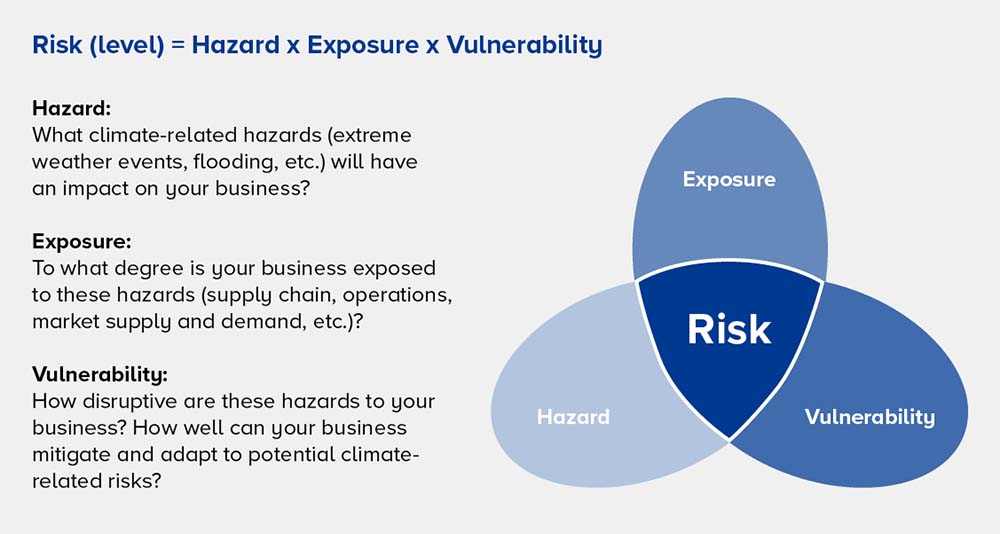
Source: ClimatePartner
Figure 3. Sample Climate Risk Assessment Process
| Hazard | Impact | Exposure | Vulnerability at Different Global Warming Scenarios* | Overall Risk Level |
| Increased tropical storm intensity | Operational disruptions, vessel damage, dangerous working conditions, infrastructure damage in coastal flood zones | High | 1°C scenario – Medium 2°C scenario – High 3°C scenario – High | High |
| Energy pricing | Increased costs for emissions-intensive energy sources | Medium | 1°C scenario – Medium 2°C scenario – Medium 3°C scenario – High | Medium |
| Lengthened wildfire seasons | Supply chain disruptions in affected areas | Low | 1°C scenario – Low 2°C scenario – Low 3°C scenario – Medium | Low |
Measuring Emissions
Even for those not subject to GHG emissions reporting regulations, all industry members should quantify their emissions. Having an understanding of the emissions profile of an organization allows for a tailored approach in reducing emissions, by prioritizing the targeting of emissions sources that can have the most impact. Additionally, as shipping operations often fall in other companies’ Scope 3 emissions, ports and marine industry actors have already started to receive, or can expect to receive, requests for emissions data from customers.
The GHG Protocol provides detailed emissions calculations guidance. As data collection usually presents a significant challenge, especially for Scope 3 emissions, the guidance includes information on the best methods to use based on available data, as an organization ramps up its data collection abilities. With fuel combustion being the most significant source of emissions for the industry, the IMO released a set of guidelines on calculating life cycle GHG intensity of marine fuels. For ports, the EPA has published GHG inventory guidance for port-related and goods movement mobile source emissions.

As climate-related disclosure and mitigation requirements continue to evolve, understanding the latest regulatory landscape is essential for US companies. In this webinar, we cut through the jargon to provide clear insights into emerging climate-related requirements, breaking down two key federal proposals and one EU regulation impacting some US-based companies. Join us to stay informed and prepared for what's ahead in climate compliance.
Reducing Emissions
There are a variety of solutions that can be used in a decarbonization strategy, some of which are listed below. There is no one optimal strategy, as it will vary based on the nature of an organization's operations and sustainability maturity.
- Target Setting—An important first step in defining an emissions reduction pathway is target setting. The Science Based Targets initiative (SBTi) provides maritime transport sector-specific guidance for short- and long-term target setting in line with the Paris Agreement and the IMO’s industry targets of limiting global warming to no more than 1.5°C. In addition to overall GHG emissions reduction targets, organizations should also consider setting emissions intensity targets. Emissions intensity is defined as the GHG emissions per unit of economic output or activity, such as dollar of revenue or tonne-kilometer of cargo transported. Using emissions intensity as a metric can be a more standardized way to compare emissions over time, even as operations scale or change.
- Sustainable Marine Fuels—With the industry’s primary source of emissions being fuel combustion, switching to more sustainable fuels can make a significant impact on emissions reduction. Figure 4 below shows various marine fuel options and their potential impact on GHG emissions.
Figure 4. GHG Emissions of Various Sustainable Marine Fuels
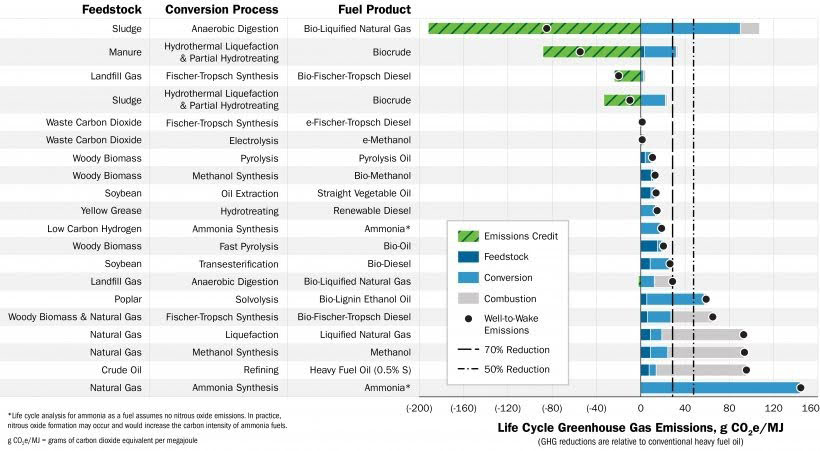
Source: Energy.gov
- Energy Efficiency—Improvements in energy efficiency can reduce energy inputs required for operations, and therefore lower emissions. Some examples of such improvements include upgrading power management systems and waste heat recovery.
- Electrification and Hybridization—Another strategy to combat emissions from marine fuels is to use electric or hybrid ships. This will be particularly useful in the coming years– as of the beginning of 2023, commercial ships had an average age of 22.2 years, while the average operational life expectancy for these ships is 20-30 years. As ships will need to be replaced, adopting electric or hybrid ships can result in significant emissions reductions.
- Port Call Optimization—Coordinating port and ship calls to reduce ship wait times can help reduce emissions through allowing ships to optimize travel speeds and fuel usage. Although this solution requires significant cooperation to overcome barriers in data standardization and sharing, ports can refer to the IMO’s Just In Time (JIT) Arrival Guide for implementation guidance.
- Shore Power—While docked at port, ships typically use their own fuel supply to power essential functions such as lighting, heating, and cooling. However, by connecting to the port’s electrical grid, also known as shore power or cold-ironing, ships can turn off their engines and reduce fuel consumption and associated emissions.
- Exhaust Treatment—Onboard carbon capture and storage (CCS) is an emerging solution to help reduce emissions from ships. By capturing exhaust gasses, liquefying them, and storing them for future offloading, case studies show that CO2 capture efficiency can reach up to 90%. To help alleviate some of the financial burden associated with these projects, shipowners can explore how to develop and sell carbon credits through retrofitting ships with CCS technologies.
- Carbon Offsetting—As some of the abovementioned strategies may require significant time and resources to implement, carbon credits can be a useful tool to supplement any decarbonization strategy. Purchasing carbon credits can help offset emissions that are more difficult to reduce, allowing businesses and organizations to improve their net carbon footprint.
- Partnerships—Collaboration can be an important tool for successfully designing and implementing a decarbonization strategy. For example, industry groups can help advise on best practices and new research, value chain members can provide financial or other incentives to promote sustainable practices, and third-party consultants can support activities including carbon accounting, materiality assessments, and roadmapping.
- Transparency and Education—Organizations should aim to be transparent with their sustainability initiatives and progress. Educating stakeholders and employees can allow for more ease in attaining the necessary funding and resources required for decarbonization projects. External certifications, such as Green Marine, can help promote credibility on progress and claims.
Looking Beyond Carbon
Although decarbonization is a topic that receives much attention due to the severity of the climate crisis, it’s also important to look beyond global warming to fully understand the impacts of the ports and maritime industry on the environment. Some of the industry’s more significant impacts are those that negatively affect marine ecosystems, biodiversity, water, and air. The table below lists some examples of such impacts.
Figure 5. The Ports and Maritime Sector’s Environmental Impacts Beyond GHG Emissions
| Impact | Description | Potential Actions to Mitigate Impact |
| Noise Pollution | Cargo vessels emit around 190 decibels of noise, which is louder than a jet engine taking off. The ability to hear is critical for the survival of many marine species. Sound can be used for locating food, communication among group mates, navigation, and avoiding predators. Noise pollution can make it difficult for marine life to use sound effectively, which can cause them to forage less, leave habitats, change other crucial behaviors, and have elevated stress levels. | Ship design changes Engine mounting Reduce travel speeds Ship electrification or hybridization |
| Invasive Species | Although ballast water is essential for the safety and stability of ships, ships without properly managed ballast water pose significant risks to marine ecosystems. Ballast water taken onboard can contain many aquatic organisms such as algae, crabs, and various animal eggs. This water can then be taken to a different part of the world and released, which has the potential to introduce invasive species into the local marine environment. | Ballast water management Ballast-free ship systems |
| Ship Strikes | All vessels have the potential to collide with various marine species, which can result in injury or death. Research shows that over 75 marine species are impacted by ship strikes, including whales, turtles, dolphins, and sea otters. | Ensure safe travel speeds and keep safe distances when marine life has been spotted Partnerships with wildlife organizations to understand and locate high risk areas |
| Ocean Acidification | GHG emissions have negative impacts on nature beyond trapping heat in the atmosphere and causing climate change. The ocean is the planet’s largest carbon sink, and as it absorbs increased amounts of CO2, chemical reactions occur, leading to an increase in the acidity of the ocean. As a result, organisms with shells, such as clams, oysters, corals, and sea urchins, have a more difficult time building and maintaining these shells. Ocean acidification also negatively impacts certain fish species’ abilities to detect predators, and these effects can ripple through food chains. | Emissions reduction and removal |
| Dredging | While dredging is necessary for maintaining the waterways that support maritime transportation, it can have adverse effects on marine ecosystems. In addition to noise pollution and potential collisions, dredging can damage habitats and remobilize contaminated sediments. | Careful planning in sensitive environments Proper disposal of contaminated sediments |
| Water Pollution | A variety of shipping activities contribute to water pollution, all resulting in negative impacts on water quality and the health of marine ecosystems. Some examples include ship wastewater release, paint leaching from ships, stormwater runoff at ports, and oil spills. | Waste management systems Anti-fouling paints Regular inspections to prevent leaks and spills |
| Air Pollution | In addition to carbon, ships release nitrogen oxides, sulfur oxides, and particulate matter (PM). PM emissions associated with shipping are estimated to be responsible for 60,000 cardiopulmonary and lung cancer deaths on an annual basis. Air pollutants can also have adverse consequences on nature, such as acid rain, toxic algal blooms, and decreased vegetation productivity. | Air quality monitoring systems Emissions reduction and removal |
| Vessel End of Life Management | Shipbreaking is dangerous not only for workers, but for the environment as well. When dismantling retired ships, high levels of toxic substances such as mercury, lead, and asbestos can be released into the air, soil, and coastal waters, leading to many nature-related hazards. | Improved waste management processes and facilities Limiting hazardous material usage in shipyards |
Skip the RFP—CarbonBetter can help
CarbonBetter Certified Offset Portfolios allow carbon buyers to participate in a variety of projects, geographies, and technologies in one simple transaction rather than navigating a lengthy and complex RFP process with multiple carbon market participants.
Learn More about CBCO 22-1Industry Highlights
Around the world, various industry players have begun implementing sustainability initiatives to work towards their environmental targets.
One industry leader driving sustainability at ports is the Port of Rotterdam in the Netherlands. A key component of their decarbonization strategy is their energy transition projects, which include a pipeline to transport residual heat from the port to local homes and businesses, utilizing battery containers to enable electrical operation of inland vessels, shore power development, and more. Other initiatives, such as energy-saving lighting, electric cranes, and modern waste treatment, have allowed the port to reduce its CO2 emissions by 14% since 2016. In addition to climate and energy, the Port of Rotterdam has established nature-related goals, principles, and initiatives to actively work towards nature restoration.
Among shipping companies, Japan-based NYK Group has developed a comprehensive ESG strategy. As part of their environmental pillar, their decarbonization roadmap includes SBTi-certified targets to reach net zero emissions by 2050, and will include both GHG emissions reduction and removals. A main focus of their emissions reduction strategy involves marine fuel switching– not only will they use less emissions-intensive fuels, they are also developing the capacity to supply other industry players with energy sources such as offshore wind and liquefied natural gas (LNG). On the GHG emissions removal side, they have made investments in support of onboard CCS technology and carbon credit development.
These sustainability-related projects of the Port of Rotterdam and NYK Group, along with other industry players, are not siloed efforts. The emergence and growth of groups such as WPSP, Green Marine, and the Sustainable Shipping Initiative (SSI) are a reflection of the positive collective change that is happening in the industry. These groups provide valuable resources and opportunities for collaboration to accelerate the development and implementation of much-needed sustainability solutions.
Conclusion
The ports and maritime industry has far-reaching environmental impacts, with the large volume of work it does to support global trade, economic growth, and crisis response. As such, there has been not only a noticeable increase in efforts to drive sustainability from within the industry, but an increase as well in external forces, such as expanding regulations and stakeholder demands. No matter what stage they are currently at in their sustainability journey, it is crucial for all industry players to take timely actions to understand and improve the relationship between their operations and the environment. Contact us today to learn how we can help your business.
Small ports can focus on energy efficiency improvements, such as upgrading to LED lighting and optimizing power management systems. Implementing shore power for docked ships can also be a significant step. Additionally, small-scale renewable energy projects like solar panels can be a feasible option.
Ports can adopt environmentally sensitive dredging practices, such as careful planning to avoid sensitive times for marine life, using silt curtains to prevent sediment dispersion, and proper disposal of dredged materials. Regular monitoring of water quality and marine ecosystems is also crucial.
Yes, ports can join initiatives like the World Ports Sustainability Program (WPSP) and Green Marine, which offer platforms for sharing best practices, collaborative projects, and sustainability benchmarks. Participation in these initiatives can provide guidance and support for implementing sustainable practices.
Advanced technologies like Geographic Information Systems (GIS) and climate modeling software can help in assessing physical risks like flooding and storm surges. For transition risks, data analytics tools can aid in regulatory compliance and tracking market trends. Additionally, IoT devices and sensors can monitor environmental conditions in real-time.
Shipping companies can focus on operational efficiencies, such as optimizing travel routes and speeds to reduce fuel consumption. Regular maintenance to ensure engine efficiency and the use of exhaust gas cleaning systems can also help. Additionally, companies can invest in carbon offsetting to compensate for their current emissions while planning for long-term fleet upgrades.

About the Author
Pankaj Tanwar is Managing Director of Climate Services at CarbonBetter. He has experience leading Fortune 100 companies through their sustainability journeys, including sustainability driven growth in the food industry. Pankaj holds an MBA from Northwestern University’s Kellogg School of Management and a BTech in Mechanical Engineering from the Indian Institute of Technology, Kanpur.



